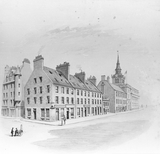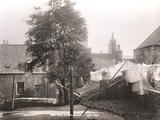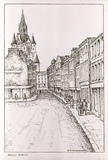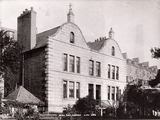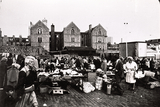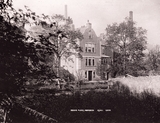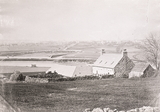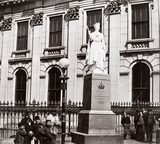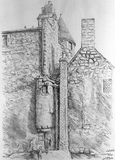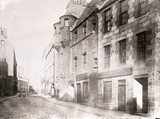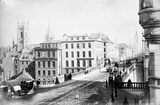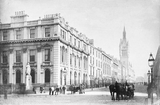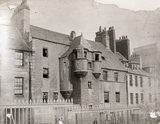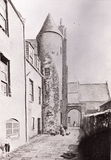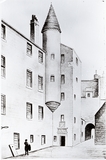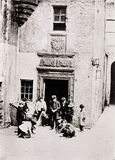|
Quick Search
|
Search Results
You searched for: More Like: 'Honeybrae House'
791 items
items as
Schoolhill
13 Old houses skirting St. Nicholas churchyard once formed part of the south side of Schoolhill. They were demolished in 1884-85 as part of a street widening scheme and the present wall and railing stand in their place. On the other side of Schoolhill (centre) can be seen the roof and turrets of George Jamesone's House, demolished in 1886.
The book Aberdeen in Byegone Days: Views of Streets and Buildings, etc. with Letterpress Description (1910) by Robert Anderson (page 26) suggests that the building in the centre of this image was the home of Burnett Carr, the grave-digger and assistant to the sexton of St. Nicholas Church.
Newspaper references indicate that Carr, a well known figure, died on 31st May 1844 (Aberdeen Journal, 5th June 1844, page 3, column 2).
This photograph looks north and shows the back of Carr's old house. Union Street junction with Broad Street
18 Union Street at its junction with Broad Street, with the tower of the Tolbooth at the right of the photograph. Huxter Row, starting below the tower at the left of the photograph, ran parallel with Union Street to the Old Town House joining Union Street at right angles. These buildings were demolished in the late 1860's and the site is now occupied by the Town House designed by Peddie and Kinnear in 1874. Broad Street looking South
19 Busy scene in Broad Street in 1833, showing buildings on the left hand side which were demolished for the extension and frontage of Marischal College. The archway at the left led through to the original buildings of Marischal College and the original Greyfriars Church. The Water House, surmounted with a pediment and clock, was erected in 1766 as a reservoir for the town's water supply. The clock and its bell were transferred to the City Hospital in 1899. Byron lived with his mother in the tenement block next to the turreted building. On the west side of the street, the tall building in the distance was the first office of the North of Scotland Bank. Gilcomston Steps, Skene Square
20 Gilcomston Steps, foot of Skene Square, in 1866. Part of old Gilcomston, these 18th century labourers' houses were known as "the rotten holes" and were among the very worst slums in the city, even by the standards of the mid 19th century. The end house with the sign was used as a smithy. All were demolished to make way for the Denburn Valley Railway, c.1866. Broad Street, Aberdeen
25 Drawing of Broad Street, at junction with Queen Street, looking towards Union Street. Spire of the Town House at the left of the image. Mackie Place
33 4-5 Mackie Place, Aberdeen, c.1870. The street was named after Robert Mackie, a skinner who was Convener of the Incorporated Trades.
At No.6 there was a haunted house known as the 'The Castle'. The Denburn flows past the back of the building. When first built, the address was 'The Galleries'. Friday Market
38 The Friday Market sited on Justice Street c.1970. It had been held in the Castlegate for many centuries until it was relocated due to the growing amount of traffic there. The Model Lodging House is in the background. This building was converted into flats in 1997.
When the Castlegate was pedestrianised the market returned to its original site. 3 Mackie Place
42 This photograph shows No. 3 Mackie Place, Aberdeen, in around 1870.
The street was named after Robert Mackie, a skinner who was Convener of the Incorporated Trades.
At No. 6 Mackie Place there was a haunted house known as the 'The Castle' or 'The White House'. It was located to the south west of Nos. 4 and 5 next to the Denburn. It was the home of the Forbes family who printed the Castle Spectre magazine.
No. 6 Mackie Place was in time demolished to make way for Esslemont Avenue. Due to the demolition, the Forbes family moved across the Denburn to the property off Skene Street known as 'the Galleries' in around 1882. It stood in the ground to the rear of No. 1 Mackie Place and has also subsequently been demolished.
No. 3 Mackie Place is located to the east of Nos. 4 and 5, on the north side of the Denburn, and still stands today. Gateway to Bridewell Prison
54 Gateway to Bridewell Prison, Rose Street, c.1880 - this massive gateway was the impressive entrance to the Bridewell in Rose Street, situated off the west end of Union Street. The Bridewell was opened in 1809 as a House of Correction and became known as the West Prison. It was in use till 1868, when it was closed and later demolished. For a short while, the site was laid out as the West End Pleasure Gardens and Recreation Grounds. The gateway had a porter's lodge and a guardhouse attached and it remained until 1883, when it was demolished to allow Rose Street to be extended northwards to link with Henry Street which in turn led on to Skene Street. Henry Street had been named after George Henry, Provost of the City between 1850-53 but the whole street then became known as Rose Street. Allenvale Cemetery from Kincorth
60 An early photograph of Allenvale Cemetery, taking shape in the middle distance, as seen from Kincorth, with Abbotswell Farm in the foreground.
A limited company called the Aberdeen Cemetery Company was established for the purpose of creating this new graveyard. A prospectus inviting public investment was published in the Aberdeen Journal of 29th January 1873. It reads as follows:
"It is well known that in Aberdeen cemetery accommodation is limited and insufficient, and it is generally admitted that its extension is necessary, and cannot much longer be delayed. It is therefore desirable to acquire additional space for that purpose, and to treat it in accordance with modern ideas and practice.
"This company has been formed for the purpose of providing an extensive Cemetery, in the neighbourhood of Aberdeen, suitable in all respects for the purposes of internment, and of easy access - but sufficiently removed from town to preserve its suburban character."
The new cemetery opened in late 1874 and, as we know, was a big hit. It was officially known as the Aberdeen Cemetery but quickly became known as Allenvale Cemetery, after the property on which it was built.
Allenvale saw major extensions in 1912 and 1932. A London syndicate purchased control of the graveyard from the Aberdeen Cemetery Company in 1958. Aberdeen Town Council subsequently took control of the cemetery in 1965 following the then owners going into liquidation and worries about Allenvale's future. Allenvale remains a fine example of a planned Victorian cemetery to this day.
Notable residents of Allenvale include John James Rickard MacLeod (1876-1935), co-discoverer of insulin, James Scott Skinner (1843-1927), fiddler and composer, and Mary Esslemont (1891-1984), the influential doctor. Though, of course, many interned at Allenvale would have their own interesting stories to tell.
In this photograph, Duthie Park, later created on the right, has yet to be landscaped. St. Machar Poorhouse, Fonthill House and Devanha House can all be seen in the distance. Old Aberdeen
71 A reproduced engraving showing the skyline of Old Aberdeen. The image looks north from around the lands of Sunnyside Farm.
In the foreground can be seen two agricultural labourers. On the skyline, going left to right, is the circular Powis Hermitage, on a hill, with its small spire, the twin spires of St. Machar Cathedral in the far distance, the tower of the Old Town House at the end of the High Street, which is protruding above the southern elevation of St. Mary's United Free Church.
Moving back along the High Street, the south facing front elevation, with bow windows, of Powis Lodge can be seen above the line of trees. The crown tower of King's College is across the street. The two minarets of the Powis Gateway are just next to it. Further along are the crenelations of Cromwell's Tower.
The tower on the far left of the image may be Dunbar's Tower.
The minaret gateway was finished in 1834 and this image likely dates from around that period. Statue of Queen Victoria
72 Statue of Queen Victoria at the junction of Union Street and St. Nicholas Street. The statue of Queen Victoria was sculpted by Alexander Brodie. The statue was inaugurated in 1866. The marble began to show weathering due to the frost and was moved to the vestibule of the Town House in 1888. The plaster model of the statue can still be seen in the Music Hall. Statue of Queen Victoria
73 A photograph showing the statue of Queen Victoria at the junction of Union Street and St. Nicholas Street. The building in the background is the Clydesdale Bank that stands next to M&S today. This fine Italian renaissance style building was originally constructed for the Town and County Bank and opened for business in May 1863.
The statue of Queen Victoria was made from marble and was sculpted by Banff born Alexander Brodie (c.1829 - 1867). The origin of this statue is closely related to another Aberdeen monument, the 1863 memorial statue of Prince Albert by Baron Marochetti, now standing, or rather sitting, in the area in front of the Central Library.
Marochetti's statue was augurated by Queen Victoria herself on 13th October 1863 and this was said to the first time the Queen had appeared at a public demonstration following the death of Albert in 1861. The Marochetti statue was the subject of great local controversy and there were various plans for an alternative, superior, memorial to the late Prince Consort. It was at a related meeting that a chap called Alexander Donald, from the Royal Tradesman of Aberdeen, moved "That a colossal statue in marble, of Her Majesty, be erected at the corner of St. Nicholas Street."
The endeavour was taken on by a variety of prominent citizens and funding was raised by public subscription. Brodie, the selected sculptor, worked on an 11-ton block of Sicilian marble for two years to complete the statue. The finished piece is 8 foot 6 inches in height and, at the request of Queen herself, depicts Victoria in Scottish regal attire. The statue stands on a substantial plinth of pink Peterhead granite.
The statue was unveiled and inaugurated on 20th September 1866 by Albert-Edward Prince of Wales, later to be King Edward VII and the subject of another of Aberdeen's notable statues. During his speech at the ceremony, the Prince said "Gentlemen, it has afforded me the greatest satisfaction to attend here today, by the wish of Her Majesty, and at your invitation, for the purpose of inaugurating a statue of the Queen, my dear mother. Her Majesty has desired me to express to you how much she appreciates the motives which have led the people of Aberdeenshire to give this lasting evidence of their attachment and loyalty to her person, of which she has so many proofs, and whose sympathy in her great sorrow has touched her so deeply."
During his visit, the Prince of Wales also received the Freedom of the City and attended the Royal Horticultural Society's Autumn Show, which was then going on in the Music Hall. An extensive account of the unveiling, the Royal visit and the town's celebrations is given in the Aberdeen Journal of 26th September 1866.
After some time at this location, the statue's marble began to show weathering due to the frost and so it was moved to the vestibule of the Town House in 1888, where it remains to this day. It stands at the foot of the building's splendid main stairway. The plaster model of Brodie's statue has also been on display in the Music Hall for many years.
A new bronze statue of an older Victoria, by sculptor Charles Bell Birch, was erected at the St. Nicholas Street location on 9th November 1893 and "the Queen" became a regular meeting place for generations of Aberdonians. To make way for the extension of Marks & Spencer, the 1893 statue moved to its current site at Queen's Cross on 22nd January 1964. Victoria now stands looking east towards Balmoral. Cumberland House
76 North wall of Cumberland House (now known as Provost Skene's House). Drawing by Davidson, 1950 Schoolhill
79 Schoolhill looking west, showing the turrets of the house occupied by the artist George Jamesone in the 17th century. The building was demolished in 1886 and the site is commemorated by a plaque on the buildings which replaced it. Union Bridge
81 Union Bridge, Aberdeen, from Bridge Street, looking east. The spires at the left belong to Kirk House, later a restaurant and bar, and to St. Nicholas Church. The corner of the Palace Hotel is just visible at the right. Union Terrace
86 Union Terrace at the junction with Union Street. The imposing building on the left is the Northern Assurance Building (Commercial Union Assurance), designed by A. Marshall Mackenzie and known locally as "The Monkey House". The statue of Prince Albert was relocated to the other end of Union Terrace to make space for the new statue of King Edward VII in 1914. Union Street
88 Union Street at the junction with St. Nicholas Street. The marble statue of Queen Victoria at the corner of St. Nicholas Street was removed to the Town House to prevent further erosion of the marble and a bronze statue of the older Queen was erected in the 1890s. George Jamesone's House
93 George Jamesone's House in Schoolhill. This house was generally believed to be the residence as well as the property of George Jamesone, the painter, known as the Scottish Van Dyck. By the 1880s it had become a lodging house, and was demolished in 1886. The site is now marked by a plaque on the buildings which replaced it. George Jamesone's House
94 George Jamesone's House in Schoolhill, c. 1885. This house was generally believed to be the residence as well as the property of George Jamesone, the painter, known as the Scottish Van Dyck. By the 1880s it had become a lodging house, and was demolished in 1886. Its site is now marked by a plaque on the buildings which replaced it. Shepherd's Court
97 An image of Shepherd's Court looking towards the Guestrow. The turreted house at 21 Guestrow was occupied by Sheriff-Depute Andrew Thomson and his wife Agnes Divie in 1673. Provost Skene's House
98 Provost Skene's House, dating from 1545, also known as Cumberland's Lodging when it was occupied by the Duke of Cumberland during his pursuit of Jacobites in 1746. It belonged to Sir George Skene of Rubislaw, Provost of Aberdeen from 1676 to 1685. In the nineteenth century, it had become the Victoria Lodging House and was only saved from demolition in 1938 by the intervention of the Queen Mother. It is now used as a museum. Provost Skene's House
100 Provost Skene's House c.1880. The building dates from 1545, and is also known as Cumberland's Lodging when it was occupied by the Duke of Cumberland during his pursuit of Jacobites in 1746. It belonged to Sir George Skene of Rubislaw, Provost of Aberdeen from 1676 to 1685. In the nineteenth century, it had become the Victoria Lodging House and was only saved from demolition in 1938 by the intervention of the Queen Mother. It is now used as a museum. |




